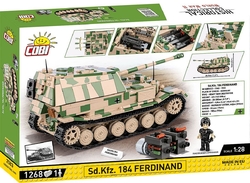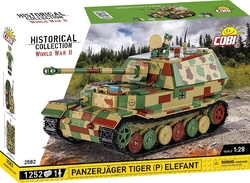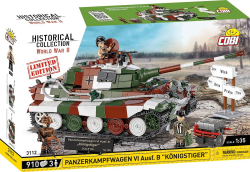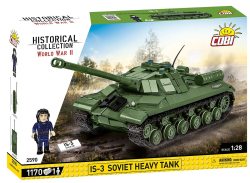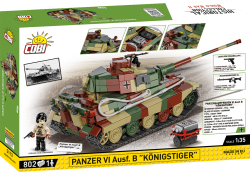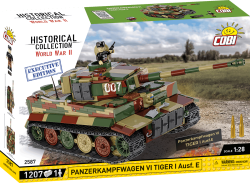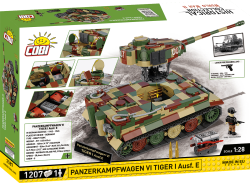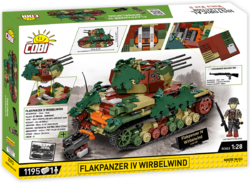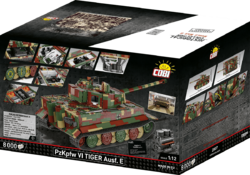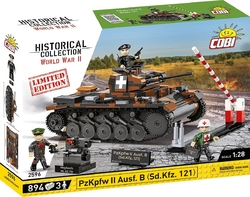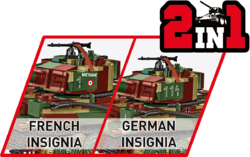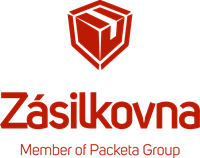Kit of German assault gun Sturmgeschütz III in field camouflage. Assembled model has fixed turret with opening hatches and opening engine cover. The Executive Edition series kit offers a 2in1 option, where the vehicle can be fitted with additional side armour. The tank tracks are functional and the model can be easily driven on non-slip surfaces. The package also includes figures of Tank Hunter Team members Mateusz Delink and Przemek Budzich, who were instrumental in the rescue, restoration and restoration of the surviving Stug III.
Show more
0 %
(0 Ranking)
| List Number: | COBI-2285 |
| EAN: | 5902251022853 |
| Warranty: | 24 months |
| Manufacturer: | COBI |
| Loyalty Points: | 6 |
| Price excluding VAT: | 939,25 Kč |
Description
Parametres
Files and Links
Discussion
Reviews

You know that:
- The StuG III or SdKfz 142 assault gun was developed by Daimler-Benz in 1938. The idea itself, however, was conceived a little earlier, based on a concept created by Erich von Manstein called the "Sturmartillerie".
- The fixed turret with a 75 mm gun was welded onto the chassis and tub of the famous Panzer III tank, which greatly simplified service logistics in difficult field conditions.
- According to the original design, the assault guns were to have an open roof, but this did not prove to be the case during tank trials.
- In December 1942, the German factories began production of an upgraded version of the G, which was fitted with a more powerful gun, a sight and a roof-mounted machine gun with folding shields. The biggest change, however, was the machine's cabin. The angular lines were replaced, the cab was widened and the sides sloped. The modifications were intended to increase crew protection, allow the installation of a modern radio station and increase the number of stored ammunition.
- In early March 1943, the German Armaments Office decided to install additional 30 mm side armour to protect the machine and crew from Russian anti-tank rifles.
- The newly produced Stugas were fitted with 70 kg of Zimmerit anti-magnetic paint.
- Independently of the instructions of the Ordnance Office, field mechanics further strengthened the armouring and machines fitted with cast-in-place concrete were also seen.
- After the changes on the Eastern Front, the StuGs performed more defensive tasks and this was to be aided by the installation of smoke bombs which were swept out of the throwers. However, they were often damaged and the smoke generated penetrated the cab to such an extent that it forced the crew to abandon the vehicle. After combat experience, the installation of smoke bombs was abandoned.
- Despite all its minor shortcomings, the StuG was an extremely effective weapon and, with 10,001 units produced, was one of the most widely used types of German armoured equipment.
- Captured machines were also used by the Czechoslovak Army under the designation ShPTK 40/75N.
- The last units were taken out of service by the Finnish Army in 1966.
Technical parameters:
- dimensions: length 6.85 m, width 2.95 m, height 2.16 m
- weight 23 900 kg
- armour 16-80 mm
- power unit V-12 Maybach HL 120 TRM gasoline engine with 220 kW output
- maximum speed 40 km/h
- fuel tank capacity 310 l
- range 165 km
- main armament KwK 40 cannon of 75 mm calibre (54 pieces of ammunition)
- secondary armament MG 34 machine gun of 7,92 mm calibre
- crew 4
From the memoirs of tank commander Hans Joachim Scholz 1943:
"At Kursk we were on fire from both sides. Our guns were aimed at the Soviet tanks, which were approaching from the left and right. It was like shooting into a pond. We destroyed one tank after another, but more and more kept coming.
Assembly instructions
| Version (series) | 08/2023 |
|---|---|
| Scale | 1 : 35 |
| Number of figurines | 2 pcs |
| Dimensions after assembly | 21 x 11 x 11 cm |
| Box dimensions | 45 x 30,5 x 6 cm |
| Number of pieces | 598 pcs |
| Package weight | 735 g |
| Recommended age | 8+ |
| Contains luminous blocks | No |
| Material | Plastic |
| Collection | World War II |
| Compatible with other brand of kits | Yes |
Discussion is empty.
There is no review for product yet













































